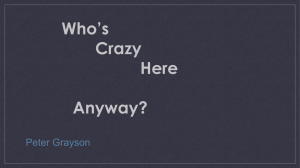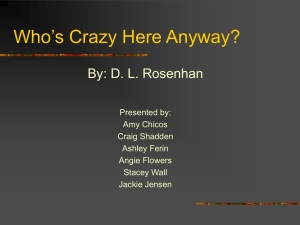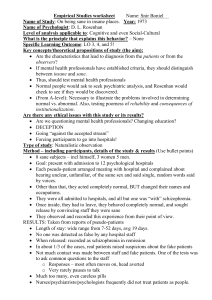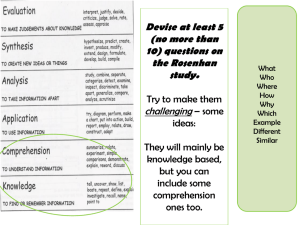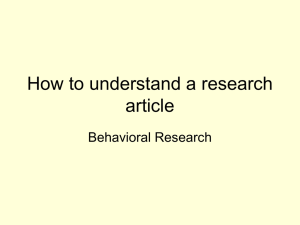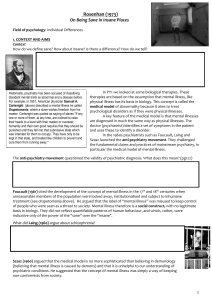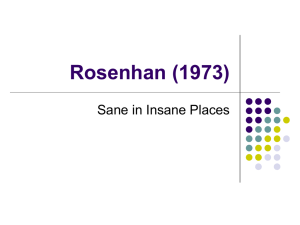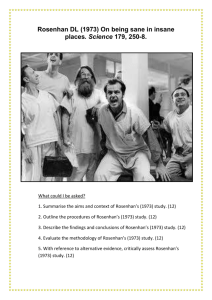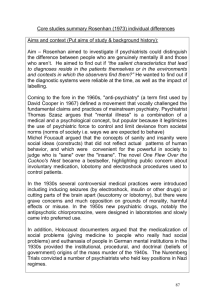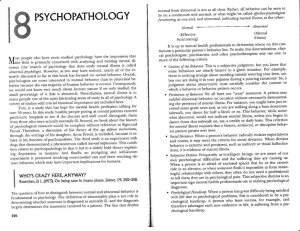Rosenhan Study: Sanity in Insane Places
advertisement
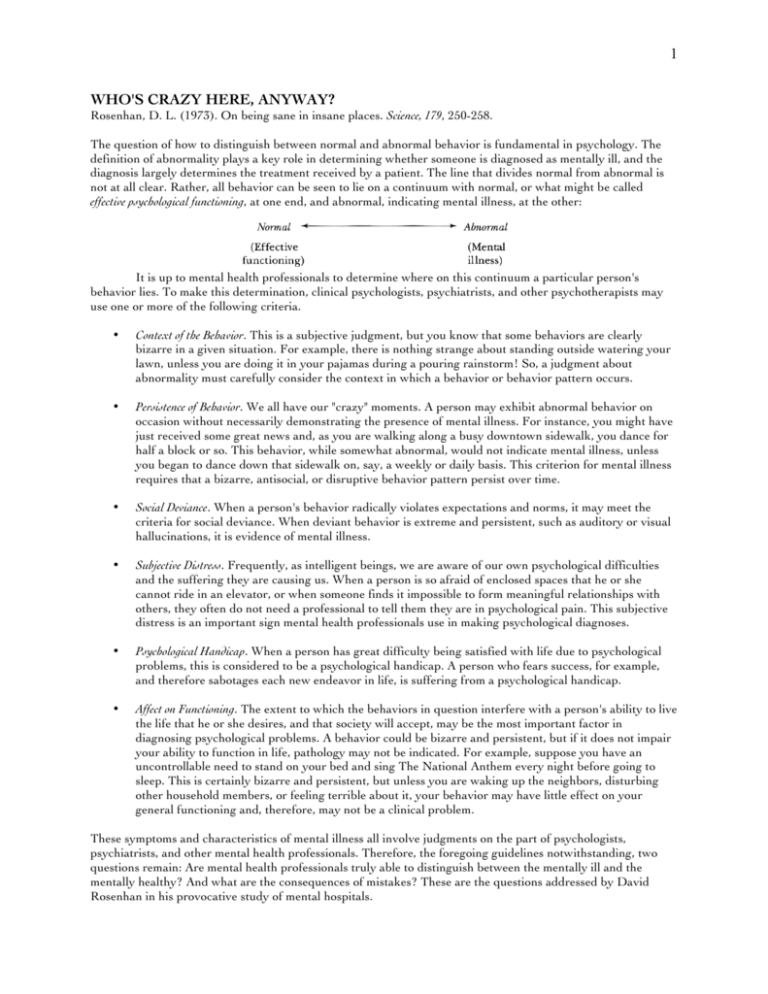
1 WHO'S CRAZY HERE, ANYWAY? Rosenhan, D. L. (1973). On being sane in insane places. Science, 179, 250-258. The question of how to distinguish between normal and abnormal behavior is fundamental in psychology. The definition of abnormality plays a key role in determining whether someone is diagnosed as mentally ill, and the diagnosis largely determines the treatment received by a patient. The line that divides normal from abnormal is not at all clear. Rather, all behavior can be seen to lie on a continuum with normal, or what might be called effective psychological functioning, at one end, and abnormal, indicating mental illness, at the other: It is up to mental health professionals to determine where on this continuum a particular person's behavior lies. To make this determination, clinical psychologists, psychiatrists, and other psychotherapists may use one or more of the following criteria. • Context of the Behavior. This is a subjective judgment, but you know that some behaviors are clearly bizarre in a given situation. For example, there is nothing strange about standing outside watering your lawn, unless you are doing it in your pajamas during a pouring rainstorm! So, a judgment about abnormality must carefully consider the context in which a behavior or behavior pattern occurs. • Persistence of Behavior. We all have our "crazy" moments. A person may exhibit abnormal behavior on occasion without necessarily demonstrating the presence of mental illness. For instance, you might have just received some great news and, as you are walking along a busy downtown sidewalk, you dance for half a block or so. This behavior, while somewhat abnormal, would not indicate mental illness, unless you began to dance down that sidewalk on, say, a weekly or daily basis. This criterion for mental illness requires that a bizarre, antisocial, or disruptive behavior pattern persist over time. • Social Deviance. When a person's behavior radically violates expectations and norms, it may meet the criteria for social deviance. When deviant behavior is extreme and persistent, such as auditory or visual hallucinations, it is evidence of mental illness. • Subjective Distress. Frequently, as intelligent beings, we are aware of our own psychological difficulties and the suffering they are causing us. When a person is so afraid of enclosed spaces that he or she cannot ride in an elevator, or when someone finds it impossible to form meaningful relationships with others, they often do not need a professional to tell them they are in psychological pain. This subjective distress is an important sign mental health professionals use in making psychological diagnoses. • Psychological Handicap. When a person has great difficulty being satisfied with life due to psychological problems, this is considered to be a psychological handicap. A person who fears success, for example, and therefore sabotages each new endeavor in life, is suffering from a psychological handicap. • Affect on Functioning. The extent to which the behaviors in question interfere with a person's ability to live the life that he or she desires, and that society will accept, may be the most important factor in diagnosing psychological problems. A behavior could be bizarre and persistent, but if it does not impair your ability to function in life, pathology may not be indicated. For example, suppose you have an uncontrollable need to stand on your bed and sing The National Anthem every night before going to sleep. This is certainly bizarre and persistent, but unless you are waking up the neighbors, disturbing other household members, or feeling terrible about it, your behavior may have little effect on your general functioning and, therefore, may not be a clinical problem. These symptoms and characteristics of mental illness all involve judgments on the part of psychologists, psychiatrists, and other mental health professionals. Therefore, the foregoing guidelines notwithstanding, two questions remain: Are mental health professionals truly able to distinguish between the mentally ill and the mentally healthy? And what are the consequences of mistakes? These are the questions addressed by David Rosenhan in his provocative study of mental hospitals. 2 THEORETICAL PROPOSITIONS Rosenhan questioned whether the characteristics that lead to psychological diagnoses reside in the patients themselves or in the situations and contexts in which the observers (those who do the diagnosing) find the patients. He reasoned that if the established criteria and the training mental health professionals have received for diagnosing mental illness are adequate, then those professionals should be able to distinguish between the insane and the sane. (Technically, the words sane and insane are legal terms and are not usually used in psychological contexts. They are used here because Rosenhan incorporated them into his research.) Rosenhan proposed that one way to test mental health professionals' ability to correctly categorize would be to have normal people seek admittance to psychiatric facilities to see if they would be discovered to be, in reality, psychologically healthy. If these "pseudopatients" behaved in the hospital as they would on the outside, and if they were not discovered to be normal, this would be evidence that diagnoses of the mentally ill are tied more to the situation than to the patient. METHOD Rosenhan recruited eight subjects (including himself) to serve as pseudopatients. The eight participants (three women and five men) consisted of one graduate student, three psychologists, one pediatrician, one psychiatrist, one painter, and one homemaker. The subjects' mission was to present themselves for admission to 12 psychological hospitals, in five states on both the east and west coasts of the United States. All the pseudopatients followed the same instructions. They called the hospital and made an appointment. Upon arrival at the hospital they complained of hearing voices that said "empty," "hollow," and "thud." Other than this single symptom, all subjects acted completely normally and gave totally truthful information to the interviewer (except that they changed their names and occupations). All the subjects were admitted to the various hospitals, and all but one was admitted with a diagnosis of schizophrenia. Once inside the hospital, the pseudopatients displayed no symptoms whatsoever and behaved normally. The participants had no idea when they would be allowed to leave the hospital. It was up to them to gain their release by convincing the hospital staff that they were healthy enough to be discharged. All the subjects took notes of their experiences. At first, they tried to conceal this activity, but soon it was clear to all that this secrecy was unnecessary, because note-taking behavior was seen as just another symptom of their illness. They all desired to be released as soon as possible, so they behaved as model patients, cooperating with the staff and accepting all medications (which were not swallowed, but flushed down the toilet). RESULTS The length of hospital stay for the pseudopatients ranged from 7 days to 52 days, with an average stay of 19 days. The key finding in this study was that not one of the pseudopatients was detected by anyone on the hospital staff. When they were released, their mental health status was recorded in their files as schizophrenia in remission. There were other interesting findings and observations. While the hospital's staff of doctors, nurses, and attendants failed to detect the subjects, the other patients could not be so easily fooled. In three of the pseudopatients' hospitalizations, 35 out of 118 real patients voiced suspicions that the subjects were not actually mentally ill. They would make comments such as, "You're not crazy! You're a journalist or a reporter. You're checking up on the hospital!" Contacts between the patients (whether subjects or not) and the staff were minimal and often bizarre. One of the tests made by the pseudopatients in the study was to approach various staff members and attempt to make verbal contact by asking common, normal questions (e.g., When will I be allowed grounds privileges? or When am I likely to be discharged?). Table 1 summarizes the responses they received. 3 When the pseudopatient received a response, it frequently took the following form: PSEUDO PATIENT: "Pardon me, Dr. ___________. Could you tell me when I am eligible for grounds privileges?" PSYCHIATRIST: "Good morning, Dave. How are you today?" The doctor then moved on without waiting for a response. In contrast to the severe lack of personal contact in the hospitals studied, there was no shortage of medication. The eight pseudopatients in this study were given a total of 2,100 pills that, as mentioned, were not swallowed. The subjects noted that many of the real patients also secretly disposed of their pills down the toilet. Another anecdote from one of the pseudopatients tells of a nurse who unbuttoned her uniform to adjust her bra in front of a dayroom full of male patients. It was not her intention to be provocative, according to the subject's report, but she simply did not consider the patients to be real people. DISCUSSION Rosenhan's study demonstrated that normal people often cannot be distinguished from the mentally ill in a hospital setting. According to Rosenhan, this is because of the overwhelming influence of the psychiatric-hospital setting on the staff's judgment of the individual's behavior. Once patients are admitted to such a facility, there is a strong tendency for them to be viewed in ways that ignore their individuality. The attitude created is: "If they are here, they must be crazy." More important, is what Rosenhan refers to as the stickiness of the diagnostic label. That is, when a patient is labeled as schizophrenic, it becomes his or her central characteristic or personality trait. From the moment the label is given and the staff knows it, they perceive all of the patient's behavior as stemming from the diagnosis, thus, the lack of concern or suspicion over the pseudopatients' note taking, which was perceived as just another behavioral manifestation of the psychological label. The hospital staff tended to ignore the situational pressures on patients and saw only the behavior relevant to the pathology assigned to the patients. This was demonstrated by the following observation of one of the subjects: One psychiatrist pointed to a group of patients who were sitting outside the cafeteria entrance half an hour before lunchtime. To a group of young resident psychiatrists he indicated that such behavior was characteristic of the "oralacquisitive" nature of the syndrome. It seemed not to occur to him that there were simply very few things to do in a psychiatric hospital besides eating. (p. 253) Beyond this, the sticky diagnostic label even colored how a pseudopatient's history would be interpreted. Remember, all the subjects gave honest accounts of their pasts and families. Here is an example from Rosenhan's research of a pseudopatient's stated history, followed by its interpretation by the staff doctor in a report after the subject was discharged. The subject's true history was as follows: The pseudopatient had a close relationship with his mother, but was rather remote with his father during his early childhood. During adolescence and beyond, however, his father became a very close friend while his relationship with his mother cooled. His present relationship with his wife was characteristically close and warm. Apart from occasional angry exchanges, friction was minimal. The children had rarely been spanked. (p. 253) The director's interpretation of this rather normal and innocuous history was as follows: This white 39-year-old male manifests a long history of considerable ambivalence in close relationships which begins in early childhood. A warm relationship with his mother cools during his adolescence. A distant relationship with his father is described as becoming very intense. Affective stability is absent. His attempts to control emotionality with his wife and children are punctuated by angry outbursts and, in the case of the children, spankings. And while he says he has several good friends, one senses considerable ambivalence embedded in those relationships also. (p. 253) 4 There was no indication that any of the staff's distortions were done intentionally. They believed in the diagnosis (in this case, schizophrenia) and interpreted a patient's history and behavior in ways that were consistent with that diagnosis. Excerpted with permission from Rosenham, D.L. (1973), "On Being Sane in Insane Places," Science, 179:250-258. Copyright 1973 American Association for the Advancement of Science. SIGNIFICANCE OF FINDINGS Rosenhan's study shook the mental health profession. The results pointed out two crucial factors. First, it appeared that the sane could not be distinguished from the insane in mental hospital settings. As Rosenhan himself stated in his article, "The hospital itself imposes a special environment in which the meaning of behavior can be easily misunderstood. The consequences to patients hospitalized in such an environment ... seem undoubtedly countertherapeutic" (p. 257). Second, Rosenhan demonstrated the danger of diagnostic labels. Once a person is labeled as having a certain psychological condition (such as schizophrenia, manic-depressive illness, etc.), that label eclipses any and all of his or her other characteristics. All behavior and personality characteristics are seen as stemming from the labeled disorder. The worst part of this sort of treatment is that it can become self-confirming. That is, if a person is treated in a certain way consistently over time, he or she may begin to behave that way. Out of Rosenhan's work grew greater care in diagnostic procedures and increased awareness of the dangers of applying labels to patients. Additionally, the problems addressed by his study began to decline with the decrease in patients confined to mental hospitals. This decrease in hospital populations was brought about by the discovery and widespread use of antipsychotic medications, which have the power to reduce symptoms in most patients enough for them to live outside a hospital and in many cases lead relatively normal lives. Concurrent to this was the growth of community mental health facilities, crisis intervention centers, and behavior therapies that focus on specific problems and behaviors and tend to avoid labels altogether. This does not imply by any means that the mental health profession has eliminated labels. However, largely because of Rosenhan's research and other research in the same vein, psychiatric labels are now used carefully and treated with the respect their power demands. QUESTIONS AND CRITICISMS One research and teaching hospital whose stall had heard about Rosenhan's findings before they were published doubted that such mistakes in diagnosis could be made in their hospital. To test this, Rosenhan informed the hospital staff that during the next three months one or more pseudopatients would try to be admitted to their psychiatric unit. Each staff member was asked to rate each presenting patient on a 10-point scale as to the likelihood that he or she was a pseudopatient. At the end of three months, 193 patients had been admitted. Of those, 41 were considered with high confidence to be pseudopatients by at least one staff member. Twenty-three were suspected by at least one psychiatrist, and 19 were identified as pseudopatients by one psychiatrist and one other staff member. Rosenhan (the tricky devil) had not sent any pseudo patients to the hospital during the three-month period! "The experiment is instructive," states Rosenhan. "It indicates that the tendency to designate sane people as insane can be reversed when the stakes (in this case prestige and diagnostic ability) are high. But one thing is certain: Any diagnostic process that lends itself so readily to massive errors of this sort cannot be a very reliable one" (p. 252). Rosenhan replicated this study several times in 12 hospitals between 1973 and 1975. Each time he found similar results (see Greenberg, 1981, and Rosenhan, 1975). However, other researchers dispute the conclusions Rosenhan drew from this research. Spitzer (1976) has argued that while the methods used by Rosenhan appeared to invalidate psychological diagnostic systems, in reality they did not. For example, it should not be difficult for pseudopatients to lie their way into a mental hospital, since many such admissions are based on verbal reports (and who would ever suspect someone of using trickery to get into such a place?). The reasoning here is that you could walk into a medical emergency room complaining of severe intestinal pain and you might get yourself admitted to the hospital with a diagnosis of gastritis, appendicitis, or an ulcer. Even though the doctor was tricked, the diagnostic methods were not invalid. Additionally, Spitzer has pointed out that although the pseudopatients behaved normally once admitted to the hospital, such symptom variation in psychiatric disorders is common and does not mean that the staff was incompetent in failing to detect the ruse. 5 The controversy over the validity of psychological diagnosis that began with Rosenhan's 1973 article continues. Regardless of the eventual outcome, there is little question that Rosenhan's study remains one of the most influential in the history of psychology. RECENT APPLICATIONS As an indication of this continuing controversy, we can consider two of many studies that have used Rosenhan's research in challenging the validity of diagnoses made by mental health professionals. One of these is by Thomas Szasz, a psychiatrist who has been a well-known critic of the concept of mental illness since the early 1970s. His contention has been that mental illnesses are not diseases and cannot be properly understood as such, but rather must be seen as problems in living that have social and environmental causes. In one article, he makes the case that the crazy talk exhibited by some who have been diagnosed with a mental illness "is not a valid reason for concluding that a person is insane" simply because one person (the mental health professional) cannot comprehend the other (the patient) (Szasz, 1993, p. 61). Another study building on Rosenhan's 1973 article examined how, in some real life situations, people may purposely fabricate symptoms of mental illness (Broughton & Chesterman, 2001). The case study discussed in the article involved a man accused of sexually assaulting a teenage boy. When the perpetrator was evaluated for psychiatric problems, he displayed various psychotic behaviors. Upon further examination, clinicians found that he had faked all of his symptoms. The authors point out that traditionally, mental health professionals have assumed the accuracy of patient statements in diagnosing psychological disorders (as they did with Rosenhan's pseudopatients). However, they suggest that inventing symptoms "is a fundamental issue for all psychiatrists, especially [when] ... complicated by external socio-Iegal issues which could possibly serve as motivation for the fabrication of psychopathology" (p. 407). In other words, we have to be careful that criminals are not able to fake mental illness as a "get-out-of-jail free card." How do the people themselves feel who have been given a psychiatric diagnostic label? In a survey of more than 1300 mental health consumers, Wahl, (1999) asked about their experiences of being discriminated against and stigmatized. The majority of respondents reported feeling the effects of the stigma surrounding mental illness from various sources, including community members in general, family, church members, coworkers, and even mental health professionals. In addition, the author reported, "The majority of respondents tended to try to conceal their disorders and worried a great deal that others would find out about their psychiatric status and treat them unfavorably. They reported discouragement, hurt, anger, and lowered selfesteem as a result of their experiences and urged public education as a means for reducing stigma" (p. 467). Perhaps psychologists are making some progress on the public education front about mental illness. In a study by Boisvert and Faust (1999), subjects were presented with scenarios about an employee who behaved in a violent manner toward his boss. The scenarios varied in the amount of stress the employee was experiencing, and in some of the scenarios the employee was described as having been previously diagnosed with schizophrenia. The researchers predicted that subjects would be more likely to attribute the violence to the employee's personality when the schizophrenia label was attached, but would lean more toward blaming the environmental stress when there was no evidence of mental illness. Guess what. They found just the opposite. As stress increased, the subjects blamed the personality of the employee less, regardless of the presence of the schizophrenia label. Furthermore, the researchers obtained the same results whether the participants were reallife, practicing mental health clinicians or college students. So, it is hoped we can take some comfort in this evidence that tolerance and understanding of mental illness is increasing. The reality is that, so far, diagnosing mental illnesses continues to be as much art as it is science. Chances are we will never do away with labels; they appear to be a necessary part of effective treatment of psychological disorders, just as names of diseases are part of diagnosing and treating physical illnesses. So, if we are stuck with labels (no pun intended), we must continue to work to take the stigma, embarrassment, and shame out of them. Boisvert, C., & Faust, D. (1999). Effects of the label "schizophrenia" on causal attributions ofviolence. Schizophrenia Bulletin, 25, 479-491. Broughton, N., & Chesterman, P. (2001). Malingered psychosis. Journal of Forensic Psychiatry, 12, 407-422. Greenberg, J. (1981, June/July). An interview with David Rosenhan. APA Monitor, 4-5. Rosenhan, D. L. (1975). The contextual nature of psychiatric diagnosis. Journal of Abnormal Psychology, 84, 442452. 6 Spitzer, R. L. (1976). More on pseudoscience in science and the case of the psychiatric diagnosis: A critique of D. L. Rosenhan's "On being sane in insane places" and "The contextual nature of psychiatric diagnosis." Archives of General Psychiatry, 33, 459-470. Szasz, T. (1993). Crazy talk: Thought disorder or psychiatric arrogance? British Journal of Medical Psychology, 66, 61-67. Wahl, O. (1999). Mental health consumers' experience of stigma. Schizophrenia Bulletin, 25(3), 467-478.
